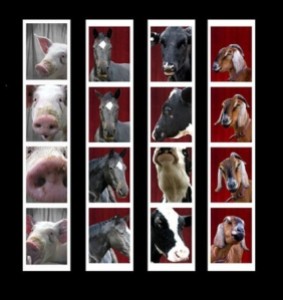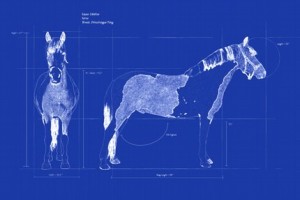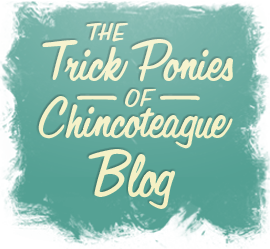Music to my Horse’s Ear
I came across a website today with some surprisingly addictive music on it. I don’t consider myself a “fan” of country music at all really, but for some reason the music of artist Mary Ann Kennedy made me laugh and want to jump in the saddle all at the same time.
Grammy nominated hit songwriter from Nashville, TN., Mary Ann Kennedy, creates music that celebrates the horse. A dedicated Parelli Natural Horsemanship student herself, Mary Ann seems to express what we all feel in our hearts for our beloved horses and the life we all live with them. Through melody, rhythm and humor in song, this is music that we horse lovers can listen and ride to.
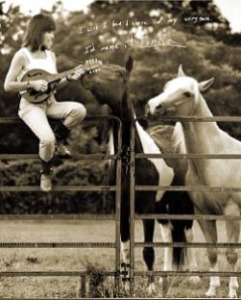 It was interesting to find out that the artist is also a Parelli follower, with many of her songs made specifically for the Parelli program. Horsenality being one of the most recognizable Parelli ones to me (I haven’t really followed the program, but on occasion I receive articles and readings from my instructor who is a dedicated follower of Parelli – I’ve discovered that I have 2 left brained ponies and one right brained one). Horses in Heaven was sort of a neat song for me, made my think of one of my childhood ponies that I lost last summer unexpectedly, he had been with me since I was 10 years old. You can see a photo tribute to my beloved, Oopsie Daisy by clicking HERE. On the lighter side of things I thought Barn Cat was pretty humorous, there are some other great ones on her website too. I thought some of the songs might be great to perform to with my horses. Anyway, enjoy!
It was interesting to find out that the artist is also a Parelli follower, with many of her songs made specifically for the Parelli program. Horsenality being one of the most recognizable Parelli ones to me (I haven’t really followed the program, but on occasion I receive articles and readings from my instructor who is a dedicated follower of Parelli – I’ve discovered that I have 2 left brained ponies and one right brained one). Horses in Heaven was sort of a neat song for me, made my think of one of my childhood ponies that I lost last summer unexpectedly, he had been with me since I was 10 years old. You can see a photo tribute to my beloved, Oopsie Daisy by clicking HERE. On the lighter side of things I thought Barn Cat was pretty humorous, there are some other great ones on her website too. I thought some of the songs might be great to perform to with my horses. Anyway, enjoy!
Boomer in Training
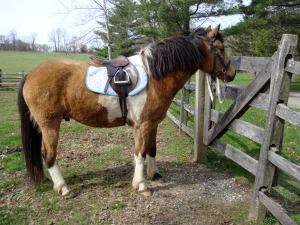
Chesapeake Boomerang 4/13/09
I decided to post a video I took today while I was working with Chesapeake Boomerang or Boomer. I wish I had a video from when I first brought him home, because the difference in him is amazing. Boomer is a 2003 registered Chincoteague Pony (which makes him 6 years old currently), I still consider him to be very young and inexperienced. When I got him last year he was broke to ride, but he still needed (and still does) a lot more improvement. Unfortunately where I keep him right now there is no ring, and the only area that is remotely useable is a semi-flat open field, that also floods. So when I first started riding him in this area, lets just say our rides together were far from calm. I was dealing with bucks and rearing and I would have never been able to ride him alone.
But from this video (sorry for the far-away shot, it was difficult to film by myself) you can see that I have a much different horse. It was a little swampy so we had some sticky spots – and this is mostly why I am only trotting him. But incase its too far away to tell – I am working on getting Boomer to stop with his hind end under him, I then proceed to ask him to back up and spin on his haunches. It might be hard to tell but I am actually barely using rein pressure, I’m instead over exaggerating my seat and leg movements, hence why I throw my legs forward for the halt and why I lean way back when asking him to back up. Eventually when Boomer’s responses to these signals are much quicker I will not over-exaggerate them as much.
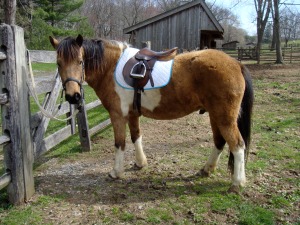
Boomer in his bitless bridle 4/13/09
After watching this video you may be asking yourself, I thought she used reward-based training methods to teach her horses, so where are the treats? And my response to that is that I don’t use it for everything, or all the time for that matter, simply because I don’t need to (again a common misconception among people is that you always need treats when riding if you use reward based methods). When I first got Boomer one of the first things I did with him was teach him to target a ball, shake hands, stand on a pedestal and give me a kiss. For these “tricks” I used clicker training (with treats) to train him. Once I had a language going with Boomer (I ask you something, you figure out what it is, you get rewarded) we had a solid way to communicate. So when I took to riding Boomer, and for example wanted to teach him to back up, all I did was sit way far back and give light taps on the rein. As I waited patiently (sometimes for a very long time) for even a step, Boomer was constantly thinking about what he had learned with me before (I ask you something, you figure out what it is, you get rewarded), so when that first step came Boomer got a great big pat and good boy. (All my ponies learn that good boy/girl means job well done – since all my treats are accompanied by this in the beginning). He didn’t need a treat right then, the “good boy” was reward enough for him. The promise of something good when he figures it out is all he needs, I truly believe horses thrive off of our approval and they simply just want to please us. Its in their nature to be “part of the herd” so to speak.
Laughter for a Rainy Day
Its pouring rain here in Eastern Pa, and as I sit at my desk at work hoping for customers to walk in the door (I own a custom framing shop – and lets face it, no one frames artwork in the rain!) I have decided today needs a little laughter. So you’re in luck – two posts for today!
Many of you following my blog by now have probably picked up on the fact that I have a love for animals – especially equines. But did you know that I not only love to train them, but I also love to photograph them? I graduated from Kutztown University in 2007 with a degree in Fine Arts and Photography, and in 2005 I really began to push the envelope with my animal photography.
I have always been fascinated by photo booths. That little strip of paper with four tiny photos seems to exude so much of the personality of its subjects. In 2005 I chose to push our familiarity with these conventional photos by inserting animals into the picture space. Portraiture need not be limited to humans; why not give animals the chance to show a part of themselves by showcasing their portraits through the means of photo booth art? I find this method and approach to animal portraiture to be both humorous and potentially fascinating. In 2006 I was a finalist in the Adobe Design Awards for this series. I was flown to Toronto, Canada for the awards ceremony and showcase of my artwork in the Royal Ontario Museum. I used many of my own horses as my models – see if you can find Chincoteague Minnow, click on the photo to the left to see more from this series – I hope it gives you a chuckle.
In 2007 I began a series of animal blueprints, my favorite of the set being the Chincoteague Pony of course (you may recognize my model as my own Chincoteague Minnow)! I took on a humorous approach to “mapping out” traits specific to different species and breeds. Click on the Image to the right to see more from this series.
If you are interested in seeing more of my work you can visit my online portfolio at www.greenhorsestudios.com. The images below are just a selection of other humorous animal portraits I have taken over the years. Hopefully they will brighten your day, and give you a laugh.
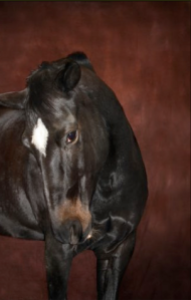
My sister's horse, Jet, poses as a supermodel
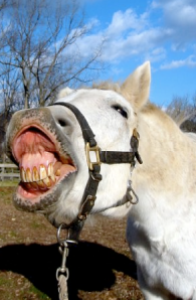
My horse, Nitro, gives a big smile for the camera
It Makes Mouths Happy
The bit is the cause of over 100 harmful effects. First and foremost, a bit is painful and it frightens a horse. It makes it difficult for a horse to be happy in its work and for a rider to achieve that harmony so essential to a partnership. It also makes it difficult for a horse to breathe, stride, perform, and stay healthy.

A common mis-conception is that you cannot get your horse "round" while using the bitless bridle
This quote is taken from the Bitless Bridle Website – a revolutionary new bridle that I just began using on the newest pony in my herd, Chesapeake Boomerang aka Boomer. Before discovering this bridle (and before I bought Boomer) I had been using mostly a hackamore bridle on Minnow (which rarely was actually engaged on him because I taught Minnow to respond to seat and leg pressure for guidance). I do admit though that in competition with Minnow I would put him in a kimberwick bit for added security as the excitement of racing sometimes overpowered him and I liked to have a little extra control. If I had known of the other alternatives then I would have tried them.

Boomer the day I bought him - before the bitless bridle
However, that was the past – onto the future – and the Bitless Bridle. When Boomer came to live with me he arrived with a snaffle bit. From the very first day that I tried him he was difficult to bridle, he would clench his teeth tight and raise his head to evade it. Although once the bit was in-place he had a very soft mouth and was quite responsive. At first I thought it was his teeth, being 5 years old he hadn’t had them floated yet. But upon having them done the issue was still present. As I continued on my path of training Boomer he began to develop a bucking problem. When I purchased him I was aware that he was known to buck on occasion – so it was nothing totally new. But this buck a little different, it started off small and then gradually progressed to a full blown bronco buck. I’m talking all four feet off the ground, intent to dump me, wild pony buck! Its amazing he never threw me! It usually happened out on the trail, brought on by excitement and adrenaline. As I began working with a local trainer to fix the issue it became evident that the real source was the bit. I discovered that when something excited Boomer (sometimes it was fear, sometimes joy at the activity at hand) he actually tested me for rein pressure. He would bump his mouth up against the bit and if he felt the slightest bit of rein pressure on his mouth he would use this as a reason to take off bucking. So now that I had the issue diagnosed, it was time to do something about it, my pony obviously had an issue with the bit.
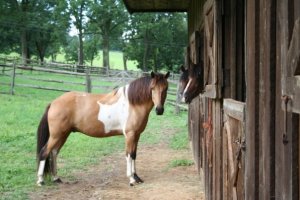
Chesapeake Boomerang at home with Blitz and Minnow
My first solution was to begin working more focused on riding him with the use of my legs and seat only. Much in the same way I started with Minnow, I began teaching Boomer to move off from my leg, stop with the shift of my hips and so on (I think this is important in the training of any horse, not just ones that have “issues” with something). He progressed rather well, but we still have a long way to go. The next step was to actually throw away my reins when Boomer began his “rein testing” before a buck. Now this is no easy task, natural human reaction to your horse on the verge of a buck is to grip onto your reins for dear life. But I succeeded in forcing myself to grab the pummel of my saddle instead of my reins – and it began working (I did feel like I was becoming some sort of rodeo rider though, haha). Boomer would begin his rein test, and when he felt no pressure at all he would immediately relax. But what I didn’t anticipate was that in his relaxation – being a pony- he would dart for any blade of grass the appeared in site. Leg pressure alone would never get my “poor starving Chincoteague Pony” to lift his head – so alas the implement of some rein pressure was needed again – and wouldn’t you know that would just send him right back into his bucking again. Ok, so new plan – now I had him in a hackamore while still trying to use no rein pressure. I saw some improvement, but instead of the buck I now had a head toss – I was willing to take that until I was able to fully train him to my seat and leg aids – but I was having extreme difficulty with still not being able to pull my ponies head up from the grass when the only area I had to work with currently was a grassy field.
While at a horse expo last month I came across a booth for the Bitless Bridle. I debated whether or not it would be helpful, but decided to give it a try. It turned out to be such a success, Boomer is no longer bucking, I can put some rein pressure on him if needed without the issue of explosive behavior, and we are have a much “happier” ride together. I am still continuing to train Boomer to respond to seat and leg pressure – and I am by no means advocating that just switching to a Bitless Bridle is the quick fix to all issues (all horses need proper training) – but I am saying that I think it is a successful training aid that “makes mouths happy”. I think from now on I will continue to use only a Bitless Bridle on all of my horses. I’m slowly converting the rest of my family, and our horses seem much happier with the switch. In the end thats all thats important, making the “work” enjoyable for your horse.
Food for Thought
I find sometimes that the “horse community” looks down on trainers that use treats to reward their horses. I think that the main resistance to this is that most people think that their horses will get grabby (which is definitely true if its not done properly) and that if they were to use treats in training it would become a crutch and they would always have to use treats from then on. These common mis-conceptions are valid, but most people that believe this are uneducated in reward-based training.
I found a video that addresses “horse mugging” when using clicker training.
I have had to address the “horse mugging” issue with all of my ponies. Being that they are ponies they can get grabby about the food, which if not addressed could lead to dangerous situations of your horse nipping at people for food. When I first began clicker training Minnow I noticed as we progressed he began to get a little grabby, he started pulling at my clothing in an effort to get his reward faster. To stop this unwanted behavior I placed him in a stall with a stall guard up. I stood on the other side with a large juicy apple in my hand. I would place the apple just in reach of Minnow’s mouth, but I would not “offer” it to him. (I consider offering to be placing my flat open palm right under his mouth.) Everytime Minnow grabbed at the apple without being offered it I closed my hand and pulled it away from him. When he did something other than grabbing at the apple (for him he began turning his head to the side – I have found that some horses “collect” themselves instead) he would then get a click and would be “offered” a different treat. It didn’t take long before Minnow realized he had to be offered his reward or else he wouldn’t get anything (I love my smart pony).
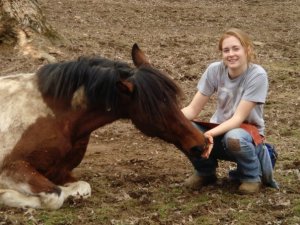
Blitz being "offered" a reward for laying down
And as far as being dependent on the treats – I think Minnow proves that you do not always need the reward to get the performance. I clicker trained him to be an exceptional mounted games pony – and not once during competition did I ever need to reward him (aside from a pat and a “good boy”). He worked and performed for me because I have made learning enjoyable for him. He doesn’t need his “treat” all of the time, but the fact that he knows it may be coming makes him work that much harder. Once I have my ponies trained for a specific skill I for the most part eliminate the treats as well as the clicker. They learn to work off my voice commands and cues – and they are happy for the occasional treat I may offer. I believe the reward-based horse training methods are one of the best out there because they tap into the horse’s number 1 focus in life – food. These methods may not be for everyone, and I’m not trying to convert everyone I meet or anything, all I’m saying is it works for me and my horses. I think any method that humanely helps you reach your goals with your horse is a success, afterall aren’t we all striving for the same thing – a partnership with our animals? I know I am.
-KD

